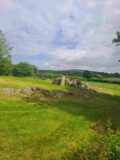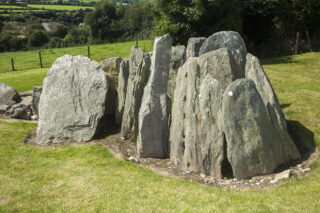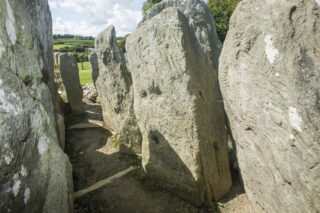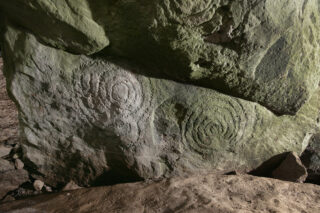Notice
Knockroe Passage Tomb is a state-owned National Monument in the care of the Office of Public Works
WARNING: It should be noted that these sites are unguided and a level of care and caution should be maintained during all stages of your visit. The Office Of Public Works (OPW) will not be held responsible for any damages, injuries, or losses that occur
Knockroe Passage Tomb
Knockroe, known locally as ‘The Caiseal’ is a Neolithic passage tomb dating to approximately 3,000BC. The tomb is one of a group of cairns located in this region, some of which are intervisible and aligned with the large mound on the summit of Slievenamon in County Tipperary. The monument is positioned along a south-western facing slate ridgeline overlooking the Lingaun River, a tributary of the Suir.
Knockroe is distinctive for a number of reasons including its extensive assemblage of megalithic art consisting of more than thirty decorated stones positioned in the two chambers and kerb. Another interesting feature is the midwinter alignment of the two tombs (east and west) to the rising and setting sun on the 21st December. While the passage tomb at Knockroe is considerably smaller than the large tumulus excavated at Knowth in the Boyne Valley in County Meath, similarities in form have been identified by archaeologists.
Archaeological excavation at Knockroe has revealed evidence for multiple burials of cremated human remains within the chambers. A wide range of artefacts, interpretable as grave goods, were found within the cremation deposits including pottery vessels, bone and antler pin fragments, bone bead fragments, pendants and spacer beads. Further archaeological investigation in the vicinity of the passage tomb has revealed cobbling and other indications of activity in the area during a later period, probably medieval times.
The ongoing programme of conservation work at Knockroe followed archaeological excavation and research. The cairn has been reinstated towards the northern side of the monument and stabilised to ensure its long-term preservation.
Visit Historic Environment Viewer for more information on Knockroe
Protect our Past - Click here to read about the importance of protecting our country’s unique heritage sites
This national monument is protected in accordance with the National Monuments Acts 1930 to 2014
Gallery
Nearby sites to visit
The Main Guard
A courthouse with centuries of history under its arches
Approx. 22.3 km from Knockroe Passage Tomb
Famine Warhouse 1848
The unlikely site of a bloody skirmish
Approx. 22.4 km from Knockroe Passage Tomb
Kilkenny Castle
The jewel in the crown of an enchanting medieval city
Approx. 26.4 km from Knockroe Passage Tomb





